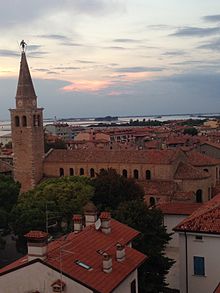You can help expand this article with text translated from the corresponding article in Italian. (September 2015) Click for important translation instructions.
|

The Basilica of Sant'Eufemia (Italian: Basilica di Sant'Eufemia) is a minor basilica in Grado, Friuli-Venezia Giulia, Italy, formerly a cathedral. It is dedicated to Saint Euphemia.
History
| This section does not cite any sources. Please help improve this section by adding citations to reliable sources. Unsourced material may be challenged and removed. Find sources: "Basilica of Sant'Eufemia, Grado" – news · newspapers · books · scholar · JSTOR (October 2021) (Learn how and when to remove this message) |
The present basilica stands on a fourth century basilica, of which not much is known. Although some features are still visible. It was ordered built by Elijah, Archbishop of Aquileia, some time in the sixth century, during his retreat from the invasion of the Lombards. After, Elijah proclaimed himself patriarch and dedicated the church to Saint Euphemia.
During the sixth through early seventh century the basilica was the seat of the pro-Roman and pro-Byzantine branch of the church until the formation of the patriarchate of Grado.
Due to the suppression of the Grado patriarchate by the Venetians it lost the title of cathedral in 1451, but shortly after in 1455 the bell tower was built, possibly to compensate for this.
Alterations to the church were made in the seventeenth and nineteenth centuries, although these were partly removed in twentieth century restorations.
Features
| This section does not cite any sources. Please help improve this section by adding citations to reliable sources. Unsourced material may be challenged and removed. Find sources: "Basilica of Sant'Eufemia, Grado" – news · newspapers · books · scholar · JSTOR (October 2021) (Learn how and when to remove this message) |
Much of the fame of the basilica comes from the incredibly well preserved sixth century floor mosaics that decorate the basilica, as it is extremely rare to find the original floor mosaics preserved in an early Christian basilica.
Features from the fourth century basilica are visible in the nave, including a visible fragment of its floor mosaics and a Corinthian capital.
The bell tower is topped with a cast copper weathervane statue of Archangel Michael, which has become a symbol of the city.
The apse is decorated with a thirteenth century Gothic fresco of Christ enthroned.
On the left side of the central nave stands a tall hexagonal pulpit, which is adorned with thirteenth century sculptured decorations.
Next to the basilica complex is an octagonal baptistery which is also adorned with sixth century floor mosaics and contains a large marble dipping basin. The basilica is mostly built from shells mixed with sand.
Gallery
References
- "Basilica di S. Eufemia". GCatholic.org. Retrieved 11 September 2015.
Links
- Profile; retrieved 24 February 2016.
Sources
- Rentetzi, Efthalia, 2008: Un'inedita figura di pesce. Parentele stilistiche tra i mosaici pavimentali di s. Maria delle Grazie e s. Eufemia a Grado, in Artonweb - Arte - Efthalia Rentetzi: un’inedita figura di pesce
Bibliography
- Bisconti, F., 2000: Temi di Iconografia Paleocristiana. Città del Vaticano
- Bovini, G., 1973: Grado Paleocristiana in Archeologia Cristiana. Bologna
- Farioli, R., 1975: Mosaici Pavimentali dell'alto Adriatico e dell'Africa settentrionale in età bizantina, in Antichità Altoadriatiche, vol. V. (paleocristiana). Ravenna
- Farioli, R., 1975: Pavimenti musivi di Ravenna. Ravenna
- Rentetzi, Efthalia, 2009: Un frammento inedito di S. Eufemia a Grado. Il pavimento musivo del Salutatorium, in Arte Cristiana, n. 850 (January–February) 2009, Vol. XCVII, pp. 51–52
- Trovabene, Giordana, nd: Il salutatorium del vescovo Elia nella cattedrale di Grado : nuove considerazioni sul mosaico pavimentale, in Atti del XV colloquio dell'Associazione Italiana per lo Studio e la Conservazione del Mosaico, pp. 41–52
- Guida rossa: Friuli-Venezia Giulia. Milano: Touring Club editore, 1999, pp. 505–508. ISBN 88-365-0007-2
45°40′36″N 13°23′07″E / 45.67654°N 13.38524°E / 45.67654; 13.38524
Categories:

